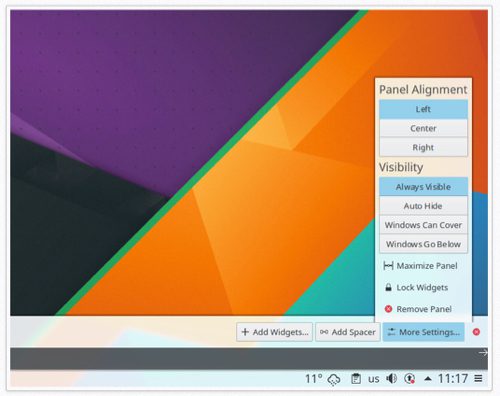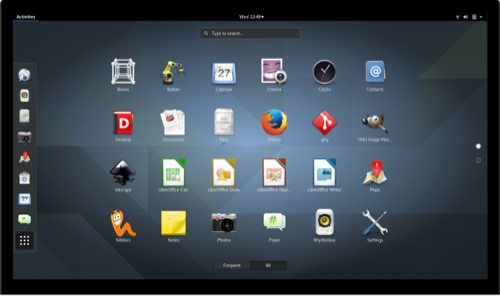Datamation content and product recommendations are
editorially independent. We may make money when you click on links
to our partners.
Learn More
GNOME vs KDE
Even with the introduction of new Linux desktop environments over the years, GNOME and KDE remain major players in the Linux desktop arena. Both desktops are mature, and come with a rock solid history of innovation and have legions of users.
In this article, I’ll compare GNOME and KDE’s stark differences. I’ll also explain the strengths and weaknesses between the two desktops as well.
GNOME vs KDE: workflow
The differences between GNOME and KDE are substantial these days. In the early days of the two desktops, there were some general workflow similarities. GNOME from the beginning to the GNOME 2 era, kept a familiar desktop layout like you might have found with Windows releases of that period. At that time, GNOME had a launcher, which then led to your applications and settings. The early GNOME interface was quite simple, but did provide an easy to navigate experience.
KDE at the time also provided a simple to use interface. KDE came with a launcher that provided you with access to your applications, settings and other functionality aspects of the desktop. The core difference with the KDE workflow was that the settings were far more detailed and controll centric.
These days the workflows have changed greatly. KDE’s workflow may be a more polished reflection of its desktop past, while GNOME itself has completely changed with its GNOME 3 desktop environment using the new GNOME shell. The GNOME 3 experience is based on a stay out of my way approach that allows its users to access menus and applications only when needed. What I mean by this is that you can hide your menu and keep your desktop free of clutter. This means no icons on the desktop, with hidden desktop elements that only appear when needed.
KDE by contrast, hasn’t changed much at all, because what worked in the past wasn’t broken. It merely needed some modern polish to provide a modern feel to a traditional desktop.

The KDE desktop
GNOME vs KDE: applications
GNOME and KDE applications share general task related capabilities, but they also have some design differences. KDE applications for example, tend to have more robust functionality than GNOME. KDE applications also tend to utilize the letter K into the names of their applications: Kmail, Kontact, Koffice, Kdenlive, among other software titles.
GNOME centric software tends to follow its own path. For example, some GNOME specific applications include: Evolution, GNOME Office, Pitivi (integrates well with GNOME), along with other Gtk based software.
KDE software is without any question, far more feature rich. For example, KDE’s personal information manager (PIM) Kontact bundles together a variety of different software into a single suite. While Evolution on the other hand, is a single application. It’s a self contained PIM that lacks some of the functionality of Kontact (RSS reader, etc), yet thanks to an extension, has stronger support for Microsoft Exchange servers.
These differences between two applications provide an interesting contrast on how the two desktops do things differently.

The GNOME desktop
GNOME vs KDE: extended functionality
Both GNOME and KDE have the ability to extend their functionality. This is done through extensions and plasmoids (KDE specific option). With GNOME, you’re able to install extensions from the GNOME extension webpage and manage them with GNOME tweak as needed.
KDE differs somewhat, you can install extensions by compiling them manually. For KDE Plasmoids, you can browse and install these addons via the KDE Add Widgets menu. From there, Plasmoids can be downloaded or installed locally.
With both desktop environments, the functionality provided by the addons is fairly balanced. That said, the appearance between the two desktop addons differs some as they’re built to reflect the overall flow of the environment.
GNOME vs KDE: user type
Over the years I’ve found that GNOME and KDE tend to attract different types of users. In the early days of the two desktops, KDE was in the lead for attracting newer Linux users whereas GNOME of that time, didn’t. Part of this reason is because it was before Ubuntu became a highly sought after distro. The newbie friendly distros at that time almost always relied on KDE as their primary desktop.
Flash forward to recent years, we see the GNOME (shell) taking KDE’s place in terms of being the goto newbie experience. Cinnamon, among other desktop environments are based on the GNOME shell, a creation that came about with the GNOME 3 desktop. Cinnamon, MATE and other desktops are highly sought after by newer users as they mimic the traditional desktop found with the older GNOME 2 desktop.
GNOME 3 isn’t as big of a hit with newer users in my experience. While long time Linux users have found it nice to use, newcomers are far more likely to find something with a more traditional feel. Hence why KDE was so popular with newcomers for so many years.
GNOME vs KDE – Best Desktop?
So which is the best desktop environment? Is KDE’s advanced functionality and highly detailed settings where it’s at? Or perhaps instead, GNOME 3 is a better option as it provides a different, non-traditional desktop?
Personally, I think the real issue comes down to what one expects from their desktop. Speaking for myself, I’d have to say GNOME 3 is more likely to be used by me than KDE. While I prefer KDE’s default layout with its traditional menu and user flow, GNOME 3 is more appealing to me since it doesn’t duplicate audio handing (KDE’s Phonon).
If KDE simply opted to avoid using Phonon and let PulseAudio handle things exclusively, I’d consider using KDE as my goto desktop. Visually speaking, KDE is stunning. GNOME 3 from a visual standpoint is simply unnecessarily confusing for anyone used to a traditional desktop.
Regardless of which desktop environment you prefer, the good news is that applications built for Linux will run on both KDE and GNOME. Even though apps built on Qt blend best with KDE while gtk applications look best in a GNOME Shell environment, they’re capable of being run on any desktop. The only consideration is the additional Qt or gtk libraries that may be installed. If disk space is finite, this might be a hinderance. Rare these days as disk space is cheap, but for some older systems it could be something to be mindful of.
What say you? Even if KDE or GNOME aren’t your full-time desktop options, which one would you use if you had to choose? Hit the Comments below, I’d love to hear about it. Be sure to include specifics as to why you’d choose one Linux desktop over another.
Also see: Open Source Software List: The Ultimate List
And: 10 Open Source Skills That Can Lead to Higher Pay
- Huawei’s AI Update: Things Are Moving Faster Than We Think
FEATURE | By Rob Enderle,
December 04, 2020
- Keeping Machine Learning Algorithms Honest in the ‘Ethics-First’ Era
ARTIFICIAL INTELLIGENCE | By Guest Author,
November 18, 2020
- Key Trends in Chatbots and RPA
FEATURE | By Guest Author,
November 10, 2020
- Top 10 AIOps Companies
FEATURE | By Samuel Greengard,
November 05, 2020
- What is Text Analysis?
ARTIFICIAL INTELLIGENCE | By Guest Author,
November 02, 2020
- How Intel’s Work With Autonomous Cars Could Redefine General Purpose AI
ARTIFICIAL INTELLIGENCE | By Rob Enderle,
October 29, 2020
- Dell Technologies World: Weaving Together Human And Machine Interaction For AI And Robotics
ARTIFICIAL INTELLIGENCE | By Rob Enderle,
October 23, 2020
- The Super Moderator, or How IBM Project Debater Could Save Social Media
FEATURE | By Rob Enderle,
October 16, 2020
- Top 10 Chatbot Platforms
FEATURE | By Cynthia Harvey,
October 07, 2020
- Finding a Career Path in AI
ARTIFICIAL INTELLIGENCE | By Guest Author,
October 05, 2020
- CIOs Discuss the Promise of AI and Data Science
FEATURE | By Guest Author,
September 25, 2020
- Microsoft Is Building An AI Product That Could Predict The Future
FEATURE | By Rob Enderle,
September 25, 2020
- Top 10 Machine Learning Companies 2020
FEATURE | By Cynthia Harvey,
September 22, 2020
- NVIDIA and ARM: Massively Changing The AI Landscape
ARTIFICIAL INTELLIGENCE | By Rob Enderle,
September 18, 2020
- Continuous Intelligence: Expert Discussion [Video and Podcast]
ARTIFICIAL INTELLIGENCE | By James Maguire,
September 14, 2020
- Artificial Intelligence: Governance and Ethics [Video]
ARTIFICIAL INTELLIGENCE | By James Maguire,
September 13, 2020
- IBM Watson At The US Open: Showcasing The Power Of A Mature Enterprise-Class AI
FEATURE | By Rob Enderle,
September 11, 2020
- Artificial Intelligence: Perception vs. Reality
FEATURE | By James Maguire,
September 09, 2020
- Anticipating The Coming Wave Of AI Enhanced PCs
FEATURE | By Rob Enderle,
September 05, 2020
- The Critical Nature Of IBM’s NLP (Natural Language Processing) Effort
ARTIFICIAL INTELLIGENCE | By Rob Enderle,
August 14, 2020
SEE ALL
ARTICLES 










